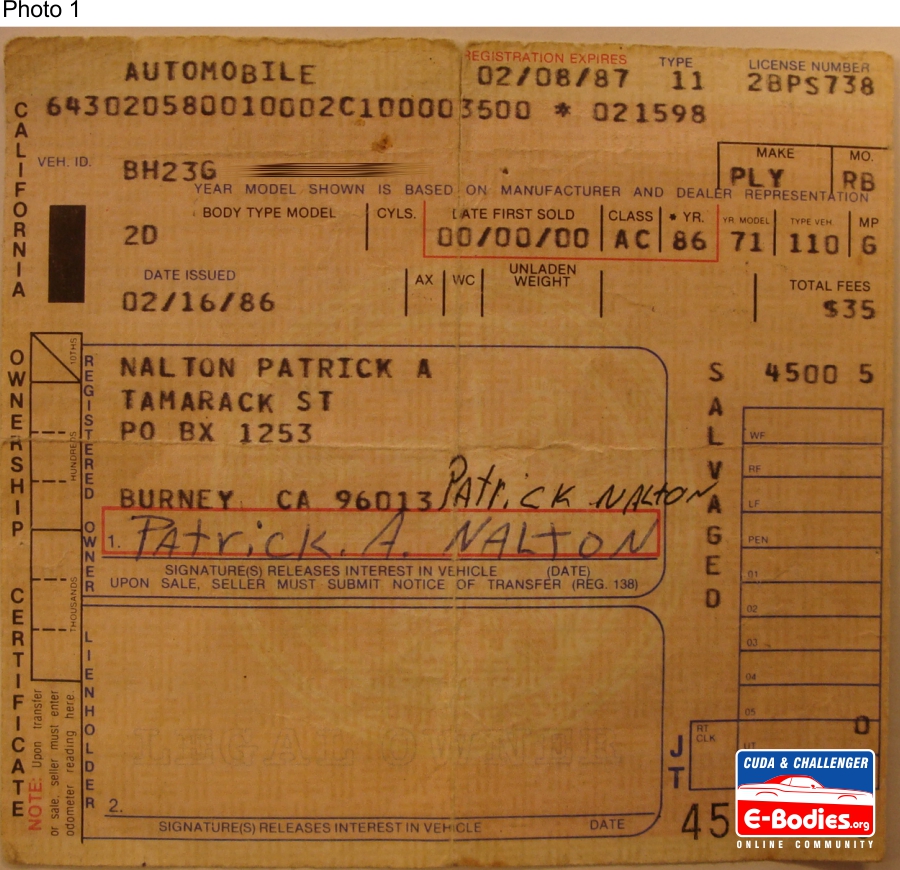Locating & Verifying all 10 E-Body VIN Numbers:

This is a step-by-step guide for locating the 10 VINs (Vehicle Identification Numbers) on a Cuda or Challenger, known as an “E-Body”. As with most collector muscle cars, the question about whether the “Numbers Match” is important. Being able to determine if the VIN numbers match on an E-Body can add tremendous value to the vehicle. It can also help you avoid overpaying for a project that is not represented correctly. So regardless of your final intentions with the vehicle it’s important to understand where all 10 VINs are located and what they mean.
There are 10 important VINs that are individually specific to each and every E-Body, but you only need the first 8 on this list (below) to be considered a true “Numbers Matching” car. The 9th (Door Mylar VIN decal) is reproduced at a high level and widely accepted on restored cars. However, if you are looking at an original un-restored car, you would need to check for #9 (Door Mylar VIN decal) if you want the car to be considered a true numbers matching original vehicle.
- Title
- Dash VIN
- Cowl VIN Serial Number
- Radiator VIN Serial Number
- Engine VIN Serial Number
- Transmission VIN Serial Number
- Fender Tag VIN
- Build Sheet VIN
- Door Mylar Data VIN Decal
- Window Sticker VIN
#10 WINDOW STICKER: Regarding #10, if you find an E-Body that has the original Window Sticker then you have found a rare piece of that cars history! The Window Sticker is also called the Monroney Sticker. Named after US Representative Mike Monroney after he sponsored the 1958 Automobile Information Disclosure Act that required new cars to display an informational sticker on the window. Since an original Window Sticker for an E-Body is very rare and not required for an E-Body to be considered a true numbers matching car we’ll start our investigation with one of the most common VIN documents, the Title.
#1 The TITLE: Start any inquiry about an E-Body project by asking the owner “do they have a “Clean Title” and is it in their name?”. The word “Title” means that the car has a state issued document showing ownership in the current owners name with the exact E-Body’s VIN. Most states will not transfer ownership without a Title. To transfer ownership the current owner (whomever’s name is printed on the title) needs to sign the ownership over to the buyer. So a title without the correct owners name on it can be difficult to transfer. The word “Clean” is used to describe a title that is free from state branding or problems. For example, a state can issue branded titles for cars that have been wrecked, stolen, abandoned or considered a total loss by an insurance company. Those titles will carry a marking that indicates its history. Look for key words like Salvage, Rebuilt, Wrecked, Theft Recovery or Abandoned (see photo 1 for an example of a Salvaged title from the 80’s). Can you see where it says Salvaged?

Branded Titles are perfectly good to use for transferring ownership, but they are no longer considered clean and come with some extra headaches. Most states require the local State Patrol to inspect branded titled vehicles before licensing and you’ll want to check with your insurance company too. Insurance companies might charge extra to insure Branded Title vehicles. Each state and insurance company is slightly different. Branded Title cars also have a perceived lower value. So you might not think it’s important to have a clean title for your E-Body because you are planning a complete ground up restoration, but when it’s all done you will still have a branded titled car that has a deemed market value of about 80% of an unbranded car.